The Wheelchair Guide
Your Wheelchair and Mobility Scooter Resource
A Closer Look at the Mobility Scooter
December 26th, 2009
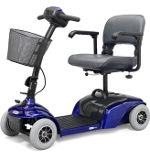 Mobility scooters are not exactly new devices and have been around for some time, with the first models first being developed around forty years ago. Up until the nineteen-eighties the cost of mobility scooters, and for that matter electric wheelchairs, was often rather prohibitive, making the device not as common. However, due to increased competition and improved manufacturing techniques, mobility scooters are relatively inexpensive today and are extremely popular among the elderly.
Mobility scooters are not exactly new devices and have been around for some time, with the first models first being developed around forty years ago. Up until the nineteen-eighties the cost of mobility scooters, and for that matter electric wheelchairs, was often rather prohibitive, making the device not as common. However, due to increased competition and improved manufacturing techniques, mobility scooters are relatively inexpensive today and are extremely popular among the elderly.
A mobility scooter is a motorized device that is used to carry a single person around their home or as they complete daily activities. Using rechargeable batteries, many mobility scooters are able to support an individual weighing more than 300 pounds over distances exceeding 10 miles on a single charge.
Differences Between Electric Wheelchairs and Mobility Scooters
The function and manufacture of mobility scooters is actually quite similar to that of an electric wheelchair, but the actual design of these two devices is usually quite different.
Since an electric wheelchair is intended for constant use by its owner, it is designed so that it can be driven directly up to a table or desk, with its captain’s chair being positioned atop a small plastic base.
Mobility scooters, on the other hand, are designed more as a walking supplement and are usually used by those who are able to walk on their own for short periods of time. So, a much longer plastic base is used, with a set of handlebars extending from the front of the base.
The handlebars, or tiller as it is usually referred to, make it impossible for a mobility scooter to be driven directly up to a table or desk in the same manner as a wheelchair could be. They also usually contain headlights, turn signals, and other gauges to indicate things like battery strength.
Due to the larger wheelbase of a mobility scooter in relation to an electric wheelchair, they are often better suited for uneven terrain and outdoor conditions.
Types of Mobility Scooters
There are actually quite a few different types of mobility scooters. There are a number of ways to classify them, such as by their range and weight capacity, as well as their intended use.
One of the most common ways to differentiate between different types of mobility scooters is by classifying them as travel scooters, heavy duty scooters, and traditional scooters.
Travel Scooters are designed so that the scooter can be easily disassembled into more manageable pieces. As the name implies, this can make it much easier to travel with, as there is no need for a vehicle scooter lift and often the heaviest piece weighs around thirty pounds, so most people can lift the scooter into their trunk without difficulty. Of course, travel scooters have fewer features and are less durable, as they are instead designed to save weight.
Heavy Duty Scooters are designed for rugged outdoor use and to support a great deal more weight, often well over 500 pounds. They also have a much higher top speed and range than other scooters, as well as being better suited for outdoor conditions. This includes reinforced bumpers, larger wheels, more comfortable seats, and a wider wheelbase. However, due to their size, transporting a heavy duty scooter usually requires a scooter carrier and they may not work as well in the tight corners of a home.
Traditional Scooters fall in between travel scooters and heavy duty scooters. They usually include more features and can often be disassembled, but the individual pieces are heavier than a travel scooter. They also usually have a larger per-charge range and weight capacity than a travel scooter would, while being less than that of a heavy duty scooter.
The Importance of the number of Wheels
The number of wheels an adult scooter has is also used to classify the scooter and can determine what type of activities it is best suited for.
For outdoor use, a four wheel scooter is usually the best choice, as it is more stable and able to provide better weight support. Most heavy duty scooters are four wheeled, as this provides better stability.
A three wheel scooter will typically be more maneuverable, as it has a smaller wheel base, making it a good choice for indoor use. Many travel scooters will use a three wheel design as this makes it lighter as well. In general, an electric scooter with three wheels has a much smaller turning radius, which also causes it to be less stable.
What is a Mobility Scooter?
December 14th, 2009
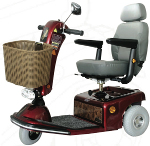 It is not uncommon for a senior to have difficulty walking and getting around. Around the home, it is possible that not being able to walk for an extended period of time isn’t all that big of an issue and in many cases, a walker or rollator will offset these difficulties. However, going places like the grocery store, shopping mall, or even walking around might not be possible, so many seniors use mobility scooters.
It is not uncommon for a senior to have difficulty walking and getting around. Around the home, it is possible that not being able to walk for an extended period of time isn’t all that big of an issue and in many cases, a walker or rollator will offset these difficulties. However, going places like the grocery store, shopping mall, or even walking around might not be possible, so many seniors use mobility scooters.
Mobility scooters are one of the most common types of mobility vehicles, which allow a senior to effortlessly get around. Many are able to travel over 10 miles per charge and some can travel even further on a single charge, with a range of over 30 miles. There are many different types of mobility scooters, but they can typically be divided into three distinct categories; Travel Scooters, Heavy Duty Scooters, and Traditional Scooters.
Travel Scooters are very popular, because they are designed to be easily transported. They can be taken apart into several pieces, all of which are light enough for the average senior to lift, with the heaviest piece often weighing less than 30 pounds. This means that the travel scooter can be dissembled quickly and placed in the trunk or back seat of a car, without the need of a special scooter lift.
While travel scooters can be very convenient, their lightweight comes at the cost of features. They also often have a shorter range than other scooters, are not quite as durable, and will typically have a lower weight capacity than a non-travel scooter.
Where travel scooter are made with transportability in mind, heavy duty scooters are designed to be driven almost anywhere. As a result, they are very heavy and will very likely require a scooter lift to transport, but they preform very well over almost all terrains. They have a much higher weight capacity than other mobility scooters, offer reinforced bumpers, a higher ground clearance, a larger more comfortable chair, and larger wheels. They also have a much larger range and top speed, with some heavy duty scooters able to travel over 10 miles per hour.
Many people who spend a great deal of time outdoors will go with a heavy duty scooter and they can be not only very practical, but also a good deal of fun to drive. However, they tend to have a rather large turning radius, which means that they wont do as well in very tight quarters, such as in a living room. This means that a heavy duty scooter is an excellent choice for outdoors and public areas, like the grocery store, but might not always be the best choice for use inside the home.
The last type of scooter is the traditional scooter and this is sort of a catch all category. If it isn’t a travel scooter or a heavy duty scooter, then it is a traditional scooter. They are more durable than travel scooters, yet not quite as durable as a heavy duty scooter. Most traditional scooters can be easily taken apart, but the individual pieces will not be as easy to handle.
For a senior, or anyone who has difficulty walking for that matter, a mobility scooter can greatly improve accessibility. These devices provide a cost effective alternative to electric wheelchairs and are very easy to use.
Choosing the Right Type of Mobility Vehicle Lift
December 5th, 2009
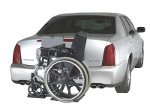 Vehicle Lifts are used to make it easier to transport a wheelchair or mobility scooter. When considering what type of vehicle lift to use, there are several factors that should be taken into account, including what type of mobility vehicle is being transported and what type of vehicle is being used. These factors will often help narrow down the options that are available to the wheelchair user, making it much simpler to select the right wheelchair lift.
Vehicle Lifts are used to make it easier to transport a wheelchair or mobility scooter. When considering what type of vehicle lift to use, there are several factors that should be taken into account, including what type of mobility vehicle is being transported and what type of vehicle is being used. These factors will often help narrow down the options that are available to the wheelchair user, making it much simpler to select the right wheelchair lift.
What Type of Mobility Vehicle is Being Transported
The type of mobility vehicle that is being transported is often the biggest factor that helps determine what type of vehicle lift to use. There are many different models of mobility vehicles, but they can usually be classified as manual wheelchairs, electric wheelchairs, and mobility scooters.
In the case of transporting a manual wheelchair, most people will simply fold it up and put it in their trunk. However, since manual wheelchairs can be rather heavy, sometimes lifting them into the back of the car can be difficult. Also, there is often simply not enough room in the car, so an external wheelchair lift is used. These are usually not motorized and attach to the hitch of a vehicle.
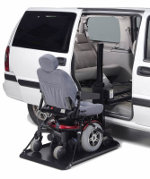 Of course, if you have a mobility scooter or an electric wheelchair, a manual wheelchair lift will not work. Instead, you would need to invest in a motorized wheelchair lift. In some cases, electric wheelchair carriers and mobility scooters carriers can be used interchangeably, but this is not always the case.
Of course, if you have a mobility scooter or an electric wheelchair, a manual wheelchair lift will not work. Instead, you would need to invest in a motorized wheelchair lift. In some cases, electric wheelchair carriers and mobility scooters carriers can be used interchangeably, but this is not always the case.
For example, often instead of a full platform, mobility scooter lifts will use a lift that has metal tracks, which are only large enough for the wheels of the scooter to fit into. When loading the scooter, the wheels will be driven into the tracks, which support the entire weight of the device. For three wheel scooters, the lift will have three tracks and for four wheeled scooters, there would be two tracks.
Some other lifts will have automatic hold down arms, which engage as the lift is being raised and hold the scooter in place without the need for tie-down straps. The automatic hold down arm works, because of the longer design of the mobility scooter, making contact with the floor portion where the use rests their feet. However, most electric wheelchairs will not work with this type of lift.
When in doubt, if the lift is labeled as an Universal Lift this means it will work with both electric wheelchairs and mobility scooters. Otherwise, it will often only work with one or the other.
What Type of Vehicle is Doing the Transporting
 The type of vehicle that will transporting the mobility vehicle is also important.
The type of vehicle that will transporting the mobility vehicle is also important.
For example, those that wished to use a passenger car have fewer options than those with a van or SUV. Typically, the only option would be a hitch mounted lift or a crane lift. The hitch mounted lift is simply inserted onto the vehicles hitch and either has its own battery pack or uses the vehicles power. Crane lifts are installed into the trunk of the car and simply hoist the wheelchair off the ground in the same manner a crane lifts a heavy load to the top of a building. One feature to look out for when shopping for crane lifts is Powered Rotation, which means the crane’s arm can be completely controlled electronically.
Those who have a SUV or van can also use the hitch mounted lift or the crane lift, but internal wheelchair lifts are also an option. These use a small platform that extends from the vehicle, allows the scooter or wheelchair to be driven onto the platform, then retracts, storing the wheelchair inside of the vehicle. These are most popular with vans, as by removing one of the rows of seats, the scooter can be stored directly behind the drives seat. In SUVs, internal lifts are used in the rear trunk area.
Those with trucks also have a few options and can of course use the crane or hitch mounted options described above. There are also several specially made truck lifts that are designed to lift the scooter off of the ground and into the bed of the pickup truck.
Where You Live or Where You Plan on Traveling to
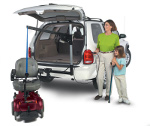 Yet another factor that helps determine what type of wheelchair lift is right, is where the person lives or where they plan on using the lift. For example, those who live in an area that gets a great deal of rain, snow, or other inclement weather, would probably want to go with a internal wheelchair lift. This way the wheelchair or scooter will be stored safely out of the weather.
Yet another factor that helps determine what type of wheelchair lift is right, is where the person lives or where they plan on using the lift. For example, those who live in an area that gets a great deal of rain, snow, or other inclement weather, would probably want to go with a internal wheelchair lift. This way the wheelchair or scooter will be stored safely out of the weather.
However, those who live in a more moderate climate would be able to use a hitch mounted wheelchair lift that stores the wheelchair outside of the vehicle. However, it is still usually recommended to invest in a cover for the wheelchair or scooter, to protect against sudden storms or road debris.
Saving Money on Mobility Scooter Accessories
November 30th, 2009
Mobility scooters are one of the most popular mobility vehicles used by seniors. They offer the convenience of an electric wheelchair, but usually cost less. This makes them an excellent choice for those who are able to walk for short periods of time, but with difficulty.
What Are Mobility Scooters?
The mobility scooter shares a number of similarities with electric wheelchairs, but the design is actually quite different. In an adult scooter, a chair sits towards the back of a base that is quite longer than most electric wheelchairs. A set of handlebars, called a tiller, extends from the front of the scooter, which allows the user to control the direction and speed of the electric scooter.
It is possible to get a three wheel or four wheel mobility scooter, with four wheel mobility scooters offering better stability and weight support. Three wheeled scooters, however, have better maneuverability and usually weigh less than 4 wheel scooters. For those who are going to be using the scooter primarily indoors, 3 wheeled scooters are often a good choice, as they work well in smaller spaces. For outdoor use or if a higher weight capacity is needed, 4 wheeled scooters are almost always the best choice.
Choosing the Right Mobility Scooter Accessory
There are actually a number of different mobility scooter accessories available, which can make the mobility vehicle more comfortable or more convenient. When considering accessories, it is important to differentiate between accessories that are specific to the actual model of scooter and generic accessories.
Scooter specific accessories, which are designed to only work with a specific brand or model of scooter, can be more expensive and are not carried by as many dealers. Some examples of scooter specific accessories would be an automatic lifting seat, which electronically raises and lowers the scooters seat, making transfers more convenient.
Generic Scooter Accessories, on the other hand, are often available much cheaper if you do a little shopping around and since they will work with many types of mobility scooters, it is not necessary to buy them from the same place you buy your scooter. Instead, it is often possible to save a great deal of money by doing some shopping around, where this is not really the case, with the price of most scooters being set by the manufacture.
For example, many mobility scooter dealers will sell visibility flags that can be attached to a scooter, making it more visible in crowds or to vehicles. A visibility flag would be considered a generic accessory, because it is not designed for a specific scooter and will instead work with most models. However, you can often get a much better deal if you goto your local bike shop and buy one of their flags. Scooter bags are much the same and you really can save a great deal of money by shopping around.
There are many types of scooter accessories, including oxygen holders, cane holders, bags, scooter trays, and baskets. By understanding the difference between scooter specific accessories and generic scooter accessories, you can save a great deal of money, because most dealers have a high markup on their accessories. These are the bread and butter, especially if you are getting your scooter for below MSRP.
Frugal TIP: Goto your local bike shop or sports store when looking for things like side-view mirrors, visibility flags, and bags for your scooter. Often, you will save money on these types of generic scooter accessories, as well as getting it right away instead of having to pay and wait for shipping.
Increasing Wheelchair Accessibility: The Front Steps
November 23rd, 2009
For wheelchair users, making sure that all areas of a home is accessible is very important, not just to make getting around easy, but also to address safety concerns. In most cases, ensuring a home is wheelchair friendly starts with the front entrance.
Depending on how a home is set up, the front or side door usually presents the first and sometimes only hurdle to a wheelchair user. So, finding a way to safely and cost effectively bridge this gap is very important and largely depends on the type of door in the home.
Most homes have at least one or two steps separating around most entrances, which can present a very big obstacle to those who use wheelchairs.
Small Wheelchair Ramps
If there are only a few steps, installing a small ramp is sometimes the quickest, easiest, and least expensive way of ensuring wheelchair access.
Ramps come in a variety of sizes and designs, both made out of wood and metal. Since the length of a wheelchair ramp is directly proportional to the length of the staircase, the lower the staircase, the shorter the ramp.
If the staircase is only a few feet high, it is usually possible to install a very short ramp, which can be removed or repositioned as necessary. Often, folding metal ramps are used, which are also popular for use with larger vans. If the ramp does not fold, then it is usually made as a single piece, much like a large board of plywood, but much stronger and more rigid.
One of the main advantages of using a short semi-permanent ramp is cost, as these tend to be the least expensive to build or purchase. They can also be quickly removed as needed and typically don’t take up all that much space. However, these types of ramps only work on very short stairways.
For larger staircases, a much longer ramp is needed. Depending on space, this sometimes means creating a zig-zag design, rather than a straight ramp. Usually, as a result of how much longer of a ramp you would need for a larger staircase, installing the ramp on the front of the house is a necessity.
Large Wheelchair Ramps
Like the smaller ramps, it is possible to go with a metal or wooden design. The wooden design is popular, as the materials to build a wheelchair ramp are not very expensive, so if you know someone who is handy, building your own wheelchair ramp is often the best choice from a monetary standpoint. Metal wheelchair ramps are also available and come in sections, making it a modular wheelchair ramp. The number of sections varies by the height of the steps and installing the ramp is simply a matter of connecting the individual sections.
Wheelchair ramps are popular as they do not require any electricity to use and usually don’t have any moving parts, so there are few points that could fail. In most cases, providing the proper type of wood is used and faulty boards are replaced as needed, a wooden wheelchair ramp will last as long as needed.
However, wheelchair ramps do require that the user is able to move themselves along the ramp and depending on the height of the staircase, they can take up a great deal of yard space.
Wheelchair Lifts
Wheelchair lifts or, as they are typically referred to in the industry, vertical platform lifts, represent one of the easiest and safest ways of increasing staircase accessibility. For all intensive purposes, a vertical platform lift is simply a self-contained elevator. Unlike the type of elevators you would see inside of a building, wheelchair lifts do not require a large shaft in the home or much modification to the home. Instead, wheelchair lifts need only be placed next to the staircase landing on a strong surface made out of wood or concrete.
To use a wheelchair lift, the user simply drives their wheelchair onto its platform and activates the call buttons. The platform than lowers or rises the distance of the staircase. One of the advantages of a wheelchair lift is that it can be used easily and requires very little effort on the part of the wheelchair user or caretaker. Simply pushing a button is all it takes to make the stairs safer. Wheelchair lifts also do not take up much front yard space.
However, wheelchair lifts represent the most expensive option, costing significantly more than building your own wheelchair ramp.
The History of the Modern Wheelchair
November 14th, 2009
Wheelchairs have become one of the most common types of mobility vehicles and are used by people in every country in the World. However, unlike many other types of inventions, the wheelchair is relatively new and the modern wheelchair is actually less than 100 years old.
When the history of the wheelchair is considered, records can be traced back thousands of years that describe devices that were used by people who were unable to or had difficulty walking. These early devices are classified as wheelchairs, but when you consider their design and the way they were used, they are incredibly different from the modern wheelchair. In these early times, building and constructing a wheelchair was very expensive and often something that was only available to royalty.
It was also very common for early wheelchairs to work more as carts or even prams, in that the person using the wheelchair had to be pushed around by others. There were, of course, several early self propelled wheelchairs, but these often used hand cranks and were more of a novelty for kings, rather than a tool for the disabled.
Towards, the end of the nineteenth century and the early twentieth century, wheelchair design began to become more standardized, in part due to lessons learned during the civil war. It was during this time that the wicker wheelchair became very popular. These wheelchairs had two wheels on the side, with a third wheel in back for support. The wheelchair itself was mostly made out of wicker, which is a made of weaving fiber together to form a strong rigid material.
The wicker wheelchairs had a very long back and were rather cumbersome. Even though they often had larger wheels on the sides, it was seldom easy or even possible to self-propel with this type of wheelchairs. Also, due to their large size, transporting a wicker wheelchair was simply not something that could be done easily or without expending abnormal resources.
Still, the design of the wicker wheelchair worked very well and hospitals all over the country adopted this design. Some people would also construct wooden wheelchairs, using a similar design to the wicker chair, only using boards of wood instead of wicker.
Wicker wheelchairs would remain popular for about twenty years, up until the mid-thirties, when a new type of wheelchair was developed. It was at this time when the E&J wheelchair was developed, which would revolutionize wheelchair design. The E & J wheelchair was designed by two inventors named Everest and Jennings.
Herbert Everest was an engineer who had suffered a back injury and was confined to a wheelchair. Together with Jennings, another Engineer, Everest set out to address several issues that made using a wheelchair in the 1930′s very difficult. Specifically they developed a folding lightweight wheelchair, which could be easily traveled with.
The E&J wheelchair used hollow metal tubes to provide excellent strength and support, without adding too much weight. It also featured large wheels on the side, which could be self propelled, by the user. Today, this design is still used and its influence can be seen in almost all manual wheelchairs.
Selecting the Right Type of Wheelchair
November 9th, 2009
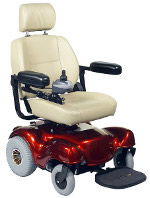 For the wheelchair user, choosing between an electric wheelchair and a manual one is often the first and hardest decision when it comes to selecting a mobility vehicle. Selecting the right wheelchair does not need to be difficult, however, and by determining your needs, the process can be made much simpler.
For the wheelchair user, choosing between an electric wheelchair and a manual one is often the first and hardest decision when it comes to selecting a mobility vehicle. Selecting the right wheelchair does not need to be difficult, however, and by determining your needs, the process can be made much simpler.
Considering the Cost of Electric and Manual Wheelchairs
One of the first factors for many trying to decide between a manual wheelchair and an electric wheelchair is price. Electric wheelchairs usually cost considerably more than manual wheelchairs.
Usually an electric wheelchair, or Power Chair, will cost between $1300 and $5000. The lower priced models usually come from lesser known wheelchair manufacturers, such as ShopRider, and the more expensive wheelchairs coming from manufacturers like Pride Mobility and Golden Technologies. While ShopRider Electric Wheelchairs are much less expensive, they do not have the same reputation as Golden Electric Wheelchairs and Pride Electric Wheelchairs.
Manual Wheelchairs usually cost much less, often around $500 and rarely over $1000. The exception to this is sports wheelchairs, which can sometimes cost just as much as electric wheelchairs. Sports wheelchairs are designed to be lightweight and durable, in addition being designed for specific types of wheelchair sports.
Considering the Wheelchair User’s Needs and Abilities
Another consideration when trying to decide whether to go with a power chair or a manual wheelchair is the abilities of the wheelchair user and how the wheelchair will be used. Depending on the users ability, using a manual wheelchair may not be an option, as they require a great deal of upper body strength. Even people who are in excellent shape find that a manual wheelchair can be very strenuous.
In regards to how the wheelchair will be used, it is important to spend some time thinking about what places you are likely to take the wheelchair. If it is just going to be used in the home most of the time, having an electric wheelchair may very well be unnecessary.
However, those who plan on using their wheelchair to travel across more than a mile or two each day, such as a college student, may find that an electric wheelchair is a much better choice. This is because most electric wheelchairs, even the lower end models, can travel more than 5 miles on a charge, with most having a range between 10 and 20 miles per charge.
Transporting the Wheelchair
Considerations on transporting the wheelchair should be thought about before actually purchasing a wheelchair, because it is a very important factor. In some regards it ties into the above topic of where the wheelchair will be used.
Typically, transporting a manual wheelchair is very easy, as they are designed to be folded up and are lightweight enough that they can easily be lifted into the back seat of a car or the trunk area. This makes using a manual wheelchair away from home very easy.
Electric wheelchairs are not as easy to transport and usually require that some sort of wheelchair lift be installed on the vehicle. This adds to the total cost of ownership of an electric wheelchair, but vehicle wheelchair lifts are very convenient and easy to use.
Selecting the right type of wheelchair need not be difficult, but it is also not a decision that should be taken lightly. It is essential to take into account the user and their needs, as well as other factors, such as cost and ease of transportation.
How to Transport a Wheelchair
November 2nd, 2009
As a result of the ADA and other legislation, many of the areas a wheelchair user wishes to go are made accessible. There are of course exceptions to the rule, but the overwhelming majority of businesses in the United States are wheelchair accessible. As a result, the most difficult part of using a wheelchair in public is generally getting it where you need it to be or transporting the wheelchair.
There are a number of different methods to transport a wheelchair, but often the most effective means is to use a vehicle wheelchair lift. Without a vehicle wheelchair lift, however, it is often still possible to transport a wheelchair.
Transporting the Wheelchair in the Trunk or Backseat
 Depending on the type of wheelchair, it is sometimes possible to simply store the wheelchair in the trunk of the vehicle or even in the back seat. This is easiest with manual wheelchairs, which are designed to be folded up when not in use.
Depending on the type of wheelchair, it is sometimes possible to simply store the wheelchair in the trunk of the vehicle or even in the back seat. This is easiest with manual wheelchairs, which are designed to be folded up when not in use.
Some electric wheelchairs and mobility scooters are also designed to be transported easily without a wheelchair lift. These mobility vehicles are usually called travel wheelchairs or travel scooters and are made to be taken apart easily, with no one piece weighing too much for a person to safely lift into their trunk. One drawback to this type of electric power chair or scooter, however, is that in order to reduce weight, a number of features are removed that are in other standard electric wheelchairs.
Using a Van Ramp
 Another option for transporting a wheelchair is to use a ramp system. There are a number of metal folding ramps available, which are designed to be used with the side door of a van. These allow the wheelchair to be driven directly into the van or to be operated by someone standing next to the wheelchair.
Another option for transporting a wheelchair is to use a ramp system. There are a number of metal folding ramps available, which are designed to be used with the side door of a van. These allow the wheelchair to be driven directly into the van or to be operated by someone standing next to the wheelchair.
While it is possible to use a ramp with other types of vehicles, this option works best with vans that have had at least one row of seats removed.
Ramps offer a cost effective wheelchair transport solution, but do not work with all vehicles and unless someone is there to help position the ramp, they can be difficult to use.
Using a Wheelchair Lift
Wheelchair lifts are more expensive than using a ramp, but are much easier to use independently. There are a number of wheelchair lift designs, but they can be broken down into interior wheelchair lifts and exterior wheelchair lift.
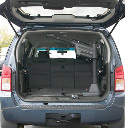 Interior wheelchair lifts are installed inside of the vehicle and store the wheelchair inside as well. There are a few different designs, but most either use a platform lift system or a crane lift system. The platform lift system allows the user to drive their wheelchair onto a small platform that extends from the vehicle. Then, once activated, the wheelchair lift will move the platform and wheelchair inside of the vehicle. You will often see this type of wheelchair lift in vans, but they can also be used in trucks and SUVs.
Interior wheelchair lifts are installed inside of the vehicle and store the wheelchair inside as well. There are a few different designs, but most either use a platform lift system or a crane lift system. The platform lift system allows the user to drive their wheelchair onto a small platform that extends from the vehicle. Then, once activated, the wheelchair lift will move the platform and wheelchair inside of the vehicle. You will often see this type of wheelchair lift in vans, but they can also be used in trucks and SUVs.
The other type of interior wheelchair lift is the crane lift, which is basically just a crane that attaches to the wheelchair and the raises it into the vehicle. Crane lifts can not be used with someone sitting on the wheelchair and it is sometimes necessary to partially disassemble the wheelchair before moving it into the vehicle.
One of the advantages of crane lifts is that they don’t take up much space, so they can be used in a car, where other wheelchair lifts would not work. A nice feature when shopping for a crane wheelchair lift is powered rotation, which means that the arm of the crane can be swiveled using a hand control. This makes it easier to swing the wheelchair into position.
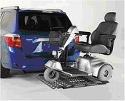 Exterior wheelchair lifts, on the other hand, almost always use a platform lift system, except unlike interior wheelchair lift, the wheelchair is stored outside of the vehicle. Exterior wheelchair lifts attach to the hitch of a vehicle, which means that they are very easy to install, don’t require modification to the vehicle, and do not take up any interior space.
Exterior wheelchair lifts, on the other hand, almost always use a platform lift system, except unlike interior wheelchair lift, the wheelchair is stored outside of the vehicle. Exterior wheelchair lifts attach to the hitch of a vehicle, which means that they are very easy to install, don’t require modification to the vehicle, and do not take up any interior space.
How to Install a Vertical Platform Lift
October 16th, 2009

The homeowner built their own gate for this porch lift.
Choosing the Right Location
Before ordering a vertical platform lift, it is important to ensure that you have a place where it can be installed in your home. These devices work by raising a platform straight up in the air to the top of a staircase, so must be placed directly next to the staircase landing. The placement is important, because when the platform of the wheelchair lift is completely raised, the user can drive their wheelchair directly from the landing onto the platform.
It is usually necessary to remove a section of the handrail from the landing. Some porch lifts offer a door that goes in place of the removed handrail, so it is not possible to drive or fall off the landing when the platform is not present. It is also possible to build your own door.
Preparing to Install
Wheelchair lifts require a solid base, which will be able to support both the weight of the lift and anyone that is using it. The best sort of base is one made out of concrete, but a wooden base will also suffice. For temporary installations, it is also sometimes possible to mount the wheelchair lift on a few 2 by 4′s, which are buried in the ground. However, this should only be used temporarily, while a concrete or permanent wooden base is being built.
In addition to providing adequate weight support, the platform should also have adequate drainage, so water does not pool under the lift when it rains. This isn’t usually a problem with wooden bases, but is common in concrete bases. If at all possible, a drain should be installed in the concrete base.
Another consideration is the way the water runs off of the roof, as most wheelchair lifts will be installed partially under the roof overhang. This means that gutters should be installed over the porch lift and they should be kept clean, to avoid water runoff.
Falling tree branches could also cause problems, so if there are any branches overhanging where the lift will be installed, they should be removed prior to installing the wheelchair lift.
An electrical outlet must also be located near the wheelchair lift.
Installing the Wheelchair Lift
Once the prep work is done, the actual installation usually goes very smoothly and quickly. Some wheelchair lifts do not require any assembly at all, but most come in a few pieces. However, even if there is some assembly required, it usually very simple.
After the lift itself has been assembled, it is necessary to move it onto its base. If the base is made out of concrete, it will be necessary to use anchor bolts drilled into the concrete. For wooden bases, it is simply a matter of screwing the bolts into the wood.
Once secured to the base, the wheelchair lift can simply be plugged in and it is ready to go.
Self-Propelled Wheelchairs and Power Chairs
October 12th, 2009
Over the history of mankind, there have always been inventions that are designed to help those who can not walk. In the grand scheme of things these devices are considered to be wheelchairs, but they are not usually what most people think of as a wheelchair. Instead, the hollow tubbed metal frame with its vinyl seats that most people first think of when considering a wheelchair is a new invention that has been around for less than 100 years.
Today, there are countless models and brands of wheelchairs, enough that it can almost be overwhelming when trying to shop for a wheelchair, but they all share a very similar design. This is not only true of most manual wheelchairs, but also electric wheelchairs.
Basic Manual Wheelchair Design
Most self-propelled manual wheelchairs have two rear wheels that are larger in size. The rear wheels have another smaller rim attached to the outside of the wheel, which allows the user to spin the wheel, without having to actually touch that parts that makes contact with the ground.
Most manual wheelchairs also have a set of push handles attached to the frame of the wheelchair, which allow it to be pushed easily. Transfer wheelchairs, which are not designed to be self-propelled, do not usually have handrims on the rear wheel and instead the rear wheels are only slightly larger than the front wheels.
The Folding Wheelchair Frame
The typical manual wheelchair is also designed to be folded when not in use, which allows it to be placed in the rear of a car without the need of a vehicle wheelchair use. This also makes them well suited for traveling. The frame of the wheelchair is made out of hollow tubes of metal, with steel being the most common type, which is very sturdy and lightweight. Other metals are also sometimes used, but they tend to be more expensive, with the main advantage of these alternate metals being their lightweight. Many sports wheelchairs will make use of a non-steel metal.
Differences Between Manual and Electric Wheelchairs
While electric wheelchairs no longer use a design that is very similar to a manual wheelchair, they do all standard design. Most consist of a small plastic base, which houses the electric motor, rechargeable batteries, axles, and other electrical components. The chair is attached to the base of the wheelchair and armrest controls are usually attached, using a simple joystick control scheme. This allows the wheelchair to be controlled by simply pushing the joystick in the desired direction. The joystick can be configured for either right hand or left hand use, by simply changing which side of the armrest it is attached to.
Of course, there are a number of people who can not use the standard wheelchair control, so there are a number of alternative wheelchair controls available. This includes wheelchairs that are controlled by head movements, the users breath, and even by remote control.
In the case of electric wheelchairs, they can usually travel between 4 and 8 miles per charge, although this is something that varies depending on the weight of the user and the type of terrain the wheelchair is driven over. For instance, driving an electric wheelchair up a hill repeatedly will wear it down faster than if it were driven across flat ground.